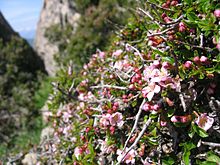- Prunus prostrata
-
Prunus prostrata 
Scientific classification Kingdom: Plantae (unranked): Angiosperms (unranked): Eudicots (unranked): Rosids Order: Rosales Family: Rosaceae Genus: Prunus Species: P. prostrata Binomial name Prunus prostrata
Labill.Prunus prostrata (Mountain,[1] Rock,[2] Spreading or Prostrate cherry) is a hardy alpine shrub found naturally above about 2000 m. up to as high as 4000 m. in Israel, Algeria, Morocco, Tunisia, Syria, Turkey, Albania, Greece, including Crete, Italy, Sardinia, Yugoslavia, France, Corsica, Spain, the Caucasus, Iran, Kashmir and Afghanistan. [3][4][5][6] It grows as tall as 1 m., more typically 0.15-0.30 m., sometimes in the crevices of vertical surfaces. The branches tend to follow the surface at any angle. Flowering patches of the plant on the rocky slopes, sometimes still snow-clad, are striking to climbers.
The bark is reddish-brown. The leaves are ovate, with serrate margins, tomentose with white down on undersurface, glabrous above. The petioles lack glands. The flowers are an unusual light rose color, coming out in April-May, solitary or in pairs, nearly sessile, with a tubular calyx. There are 22-24 stamens. The fruit is red, ovate, with thin flesh, ripening in July.
Contents
Uses
The fruit is edible but not preferred by humans. The plant's main use is as in ornamental gardening. It can be grafted to form a tree.
Classification
The name Prunus prostrata was assigned by Jacques Labillardière, the French botanist, in Icones plantarum Syriae rariorum,[7] published on his return from a plant-hunting expedition to the Middle east. Prostrata means "lying on the ground", referring to the plant's ground-hugging propensity, a mechanical necessity at high altitude. A prostrate branch bends back to the ground.
Some synonyms were created subsequently, mainly by using the now unaccepted genus Cerasus instead of Prunus. These are, in order of date:
- Cerasus humilis Moris, published in Stirp. sard. elench. 1:17. 1827[8]
Latin humilis means "on the ground." Boissert defines the variety concolor as folia utrinque glabra, "leaves smooth on both sides."
Palaeobotanical evidence
A recent study[10] of pollen and other microfossils from a core sample taken in an intermontane valley of the Segura mountains in southern Spain finds P. prostrata in a "Prunus type" located in two radiocarbon-dated zones from about 2630 BP to about 1550 BP and again from about 790 BP to present.[11] The ecology of the Prunus type was "high-altitude open pine forest." The core goes back to 8320 BP, but there is no evidence if Prunus in it before 2630.
References
- ^ Note: Mountain cherry is also one of many names used for Prunus tomentosa.
- ^ Note: Rock cherry also has been used for Prunus mahaleb.
- ^ U. S. Department of Agriculture (USDA). "Prunus prostrata Labill." (html). Germplasm Resources Information Network (GRIN) Taxonomy for Plants. http://www.ars-grin.gov/cgi-bin/npgs/html/taxon.pl?30077.
- ^ Lindley, John; Edwards, Sydenham (Illustrator) (1816). The Botanical Register: Consisting of Coloured Figures of Exotic Plants Cultivated in British Gardens; with their History and Mode of Treatment. London: Ridgways, Piccadilly. pp. pages 135–136. Downloadable Google Books. The name used by Lindley is "Birch-leaved Mountain Plum." Edwards has a full-page plate.
- ^ Loudon, J.C. (1875). Trees and Shrubs; An Abridgement of the Arboretum et Fruticum Britannicum Containing the Hardy Trees and Shrubs of Britain, Native and Foreign, Scientifically and Popularly Described; with their Propagation, Culture and Uses; and Engravings of Nearly All the Species. London: Frederick Warne & Co.. pp. pages 282–283. Downloadable Google Books.
- ^ Stewart, J. Lindsay; Brandis, Dietrich (MDCCCLXXIV). The Forest Flora of North-west and Central India: A Handbook of the Indigenous Trees and Shrubs of Those Countries. London: Wm. H. Allen & Co.. pp. pages 193–194. Downloadable Google Books.
- ^ La Billardière, Jacques-Julien Houtou de (1791). Icones plantarum Syriæ rariorum, descriptionibus et observationibus illustratæ Vol. 1. Lutetiæ Parisiorum: Impensis Autoris [etc.]. pp. Tabula (t.) 6, page 15. This rare and expensive book is in the process of or recently has been reprinted. The botanical designation of the plant is Prunus prostrata Labill. (subg. Prunus sect. Microcerasus); of the book, Icon. pl. Syr. 1:15, t. 6. 1791.
- ^ Moris, Giuseppe Giacinto (1837-1859). Flora Sardoa seu Historia Plantarum in Sardinia et adjacentibus insulis vel sponte nascentium vel ad utilitatem latius excultarum; Vol 1. Taurini: ex Regio Typographeo. pp. page 17.
- ^ Boissier, Edmond (1872). Flora Orientalis sive Enumeratio Plantarum in Oriente a Graecia et Aegypto as Indiae Fines. 1872. Genevae et Basileae: apud H. Georg, Bibliopolam. pp. page 648
- ^ Carrión, J.S.; Munuera, M.; Dupré, M.; Andrade, A. (2001). "Abrupt vegetation changes in the Segura Mountains of southern Spain throughout the Holocene". Journal of Ecology 89 (5): pages 783–797. doi:10.1046/j.0022-0477.2001.00601.x. http://www.blackwell-synergy.com/doi/pdf/10.1046/j.0022-0477.2001.00601.x. See the tables on pages 789 & 792.
- ^ For simplicity the tolerances have not been repeated here. "Present" is 1955/1956 AD.
External links
- Scott, David (1997). "Prunus prostrata". Photoflora. http://homepage.ntlworld.com/david.scott40/sg/sg971635.htm.
- Old Dominion University (2002). "PLANT SITE: Prunus prostrata Rosaceae". http://www.odu.edu/~lmusselm/plant/index.php?todo=plant&id=2000.
Categories:- Prunus
- Flora of Turkey
- Flora of Lebanon
Wikimedia Foundation. 2010.
